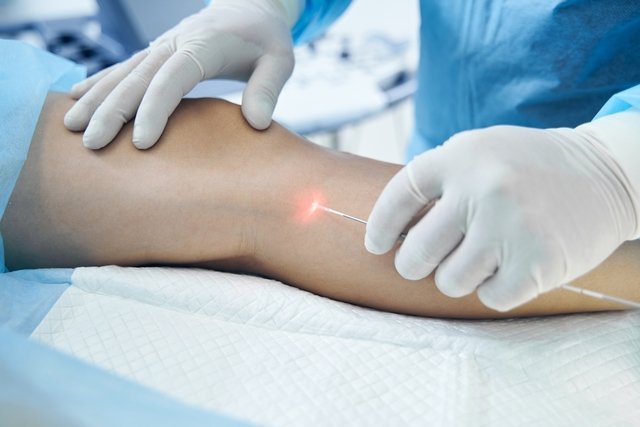Endolaser is an aesthetic treatment indicated for skin rejuvenation, fat reduction and cellulite, as it stimulates collagen production and increases skin firmness, in addition to reducing excess fat.
This type of treatment, also known as endolift, is performed by a dermatologist or plastic surgeon under local anesthesia and uses a diode laser through a very thin optical fiber inserted into the subcutaneous tissue, which causes tissue heating, without causing burns.
In addition to aesthetic treatment, the endolaser, also called endovenous laser, is indicated for the treatment of varicose veins or varicose veins, and is performed by an angiologist or vascular surgeon. Know how to identify the symptoms of varicose veins.

What is it for
The endolaser is indicated for:
- Promote skin rejuvenation;
- Lifting facial ou corporal;
- Reduce wrinkles and expression lines;
- Reduce sagging of the face, neck, jowls, eyelids, abdomen or buttocks;
- Smooth cellulite or dark circles;
- Promote localized fat burning;
- Treat spider veins, varicose veins or internal varicose veins;
Furthermore, the endolaser can also be indicated in ophthalmology to destroy abnormal blood vessels in the eye, in the case of macular degeneration, for example. Check out other treatments for macular degeneration.
The endolaser must be performed by a dermatologist, plastic surgeon, angiologist, vascular surgeon or ophthalmologist, according to the objective of the treatment.
Make an appointment with a dermatologist in the nearest region:
Taking care of your health has never been easier!
How it works
The aesthetic endolaser works by heating the subcutaneous tissue, stimulating the production of collagen by the skin, remodeling the most superficial layers of the skin, increasing its firmness and elasticity.
Furthermore, it has a lipolytic effect that breaks down fat cells, which are absorbed by the lymphatic vessels and thus reduces the amount of adipose tissue and softens cellulite.
In the case of endovenous laser, the laser is applied inside the blood vessel, promoting its cauterization and closing of the blood vessel, which allows the elimination of spider veins, varicose veins or internal varicose veins.
How is done
The endolaser can be performed using a diode laser at wavelengths of 980 and 1470 nm, and can be applied to the subcutaneous tissue or inside the blood vessel, which varies depending on the objective of the treatment.
1. Aesthetic Endolaser
The aesthetic endolaser is performed by a dermatologist or plastic surgeon, using local anesthesia.
To carry out the procedure, the doctor must follow some steps:
- Draw on the skin with a suitable pencil the places where the optical fiber will be inserted
- Apply the anesthetic to the area to be treated;
- Put on protective glasses and provide protective glasses to the person;
- Insert the optical fiber, which has a very thin tip, the thickness of a strand of hair, into the subcutaneous tissue;
- Make linear movements with the optical fiber in the areas designed on the skin for treatment;
- Remove the optical fiber at the end of the treatment.
The aesthetic endolaser is a minimally invasive treatment, as it does not require cuts in the skin, resulting in quick recovery.
2. Endolaser for saphenous veins or varicose veins
The endolaser for saphenous veins, varicose veins or spider veins, or endovenous laser, is performed by an angiologist or vascular surgeon, also using local anesthesia. In some cases, sedation may be used.
To perform the intravenous laser, the doctor must follow the following steps:
- Apply the anesthetic along the trajectory in which the laser fiber will be used;
- Insert a needle into the blood vessel, usually in the groin, at the junction between the great saphenous vein and the femoral vein, where the optical fiber will be inserted;
- Insert the optical fiber into the vein, through the needle, to the reflux point in the blood vessel. This step is guided by ultrasound;
- Apply the laser inside the blood vessel and gradually remove the optical fiber.
The intravenous laser promotes cauterization and closure of the blood vessel, which is then reabsorbed by the body itself. See other treatment options for varicose veins.
Does endolaser hurt?
The endolaser is a treatment that does not cause pain, as local anesthesia is used to avoid pain or discomfort during the procedure.
Possible risks
The main risks of the endolaser are discomfort in the treated area, skin redness, swelling or bruising.
In the case of intravenous laser, although it is rare, deep vein thrombosis, thrombophlebitis, pulmonary embolism or skin burns can occur, for example.
Furthermore, a severe allergic reaction to the anesthetic or anaphylactic shock may also occur, with symptoms that may begin immediately after application of the anesthetic, which are treated immediately by the doctor responsible for the procedure.
Another risk is anesthetic poisoning, especially when used in large quantities.
Therefore, the endolaser must be performed by a qualified doctor experienced in this type of treatment, and in a hospital or clinic with the facilities to deal with emergencies.
Who shouldn’t do
The endolaser should not be used by children or pregnant or breastfeeding women.
Furthermore, in the case of treating varicose veins, saphenous veins or spider veins, the endolaser should not be used on people with arterial circulation problems in the legs, deep vein thrombosis, or who are at increased risk of bleeding or thrombosis.

Sign up for our newsletter and stay up to date with exclusive news
that can transform your routine!
Warning: Undefined array key "title" in /home/storelat/public_html/wp-content/plugins/link-whisper-premium/templates/frontend/related-posts.php on line 12
Warning: Undefined array key "title_tag" in /home/storelat/public_html/wp-content/plugins/link-whisper-premium/templates/frontend/related-posts.php on line 13



